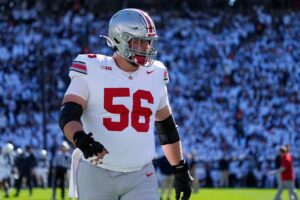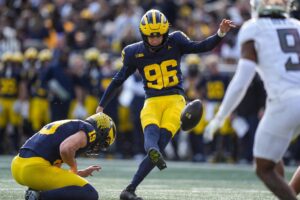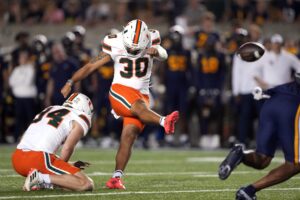A few seasons ago, we discussed at length the shifting college football landscape. In particular, we took a hard look at the evolving transfer rules. As predicted, the average number of outbound transfers per school seems to be climbing. Indeed, with the NCAA likely to approve the pending one-year automatic transfer waiver, logic tells us the numbers will be even higher this season. So far, West Virginia lost its share of players to the transfer portal. As a result, we are taking time to ask the question: are transfers the new normal in Morgantown?
Transfers The New Normal For WVU?
The Nationwide Transfer Scene
Before diving into the outbound transfer picture in Morgantown, however, we want to look at the picture across all of the Power Five schools (plus Notre Dame). That backdrop will provide important context. When counting the number of transfers per school, we focused solely on scholarship players. Plenty of schools have total outbound transfers approaching or eclipsing 20. But, in many cases, the portal database also picks up walk-on players transferring out. We exclude those from our numbers. We also exclude players who entered the transfer portal but elected to stay at their current school. While there are not many of these, we did find about a dozen of these players.
As it turns out, the number of transfers is indeed significant. 247Sports maintains a reliable transfer portal database on which we go to for these conclusions. Importantly, we usually see substantial transfer activity at the conclusion of Spring football, as players gain a better sense of where they sit on the depth chart. This year, however, we see earlier transfer entry. Through today, in fact, there are a total of 592 scholarship players that have entered the transfer portal from the schools within the Power Five conferences (including Notre Dame). The average number per school is nine.
Some conferences retain players better than others, but the difference is minor. The Big 12 leads the nation with 11 outbound transfers per school on average. The SEC follows with 10. Then, the ACC has nine; the Pac 12 has eight, and the Big Ten has eight. Notre Dame witnessed 12 student-athletes enter the portal this season.
There are a total of 31 schools (or 48%) that have 10 or more student-athletes in the portal. 18 schools (or 28%) have 12 or more there. And only eight have fewer than five in the portal. This bottom threshold is important given the annual scholarship limits. Over four years, a school can sign a maximum of 100 players. Since that school can only have 85 scholarships used at any one time, a school can only lose about four players per year and maintain a full count of scholarships.
The Past Two Seasons Of Transfers In Morgantown
We also want to look at the past two seasons of West Virginia’s outbound transfers to set the stage. In 2020, the Mountaineers saw 10 outbound transfers. Three of them saw or were expected to see significant playing time. Those players included Martell Pettaway, Josh Sills, and Kwantel Raines. Most of the remaining players added depth at key positions. Only one, Jovani Haskins, straddled the line between potential contributors and depth-only players.
Last season represented an increase for West Virginia, as only eight Mountaineers transferred out in 2019. One of those 2019 transfers–Kenny Robinson–ultimately went pro instead of going elsewhere. He was, however, a significant loss to the team. Otherwise, only Derrek Pitts and Matt Jones offered West Virginia solid play prior to their transfers.
West Virginia’s Current Outbound Transfers
So far in 2021, the Mountaineers see 12 student-athletes in the transfer portal, balanced fairly evenly on the offense and defense. West Virginia loses seven offensive players and five players from the defense. It loses three each from the offensive line and cornerback rooms.
The Depth Pieces
Many of those players have not made a significant contribution in Morgantown yet. For example, while the coaching staff had touted his potential several years ago, linebacker Charlie Benton never fully returned to form after a season-ending injury. As a result, he barely saw the field the last two seasons. Then there is Blaine Scott, who logged 34 snaps last season on the offensive line (11th on the team). Then, Tacorey Turner did not log a single snap on defense in 2020. And while he showed some promise two seasons ago, Tae Mayo saw the field on only 10 snaps this season. Finally, Zack Dobson recently transferred into Morgantown but left before he saw the field.
The Expected Transfers
Other players hardly represent surprises. Many thought Austin Kendall would transfer after the 2019 season, but he stuck it out despite being passed by Jarret Doege on the depth chart. Kendall, of course, saved the day with his second half heroics in the Liberty Bowl. That said, he was not expected to play a major role in the offense next year. Also, while we expected Junior Uzebu to come into his own this season, Brandon Yates eclipsed him early in the year on the depth chart. As a result, his decision was not a surprise.
The Unexpected Transfers
Next, we look at those who surprised us. Alec Sinkfield helped Leddie Brown shoulder the load in the backfield in 2020, logging 200 snaps and belting off over four years per carry. That said, Sinkfield never quite lived up to his promise as an explosive change-of-pace back. His production can be replaced. After all, West Virginia brought in two four star running backs in its 2021 class, Jaylen Anderson and Justin Johnson. That said, his decision was a surprise.
West Virginia also lost Ali Jennings to the portal. Jennings offered some of the steadiest hands in the wide receiver room. His commitment was solid, and his attitude seemed a great fit for Head Coach Neal Brown’s blue-collar attitude. Thus, his decision certainly surprised us. That said, he sat between fifth and seventh on the depth chart, and West Virginia brings in Kaden Prather to the room. As a result, playing time likely played a factor.
Finally, Quay Mays logged 128 snaps on the defensive line. While he did not rack up a bunch of statistics in those snaps, Mays was expected to contribute heavily in the interior after Darius Stills’ graduation. This is a loss for both depth and production that we did not expect.
The Biggest Losses
The Mountaineers’ biggest (and most surprising) loss to the portal is its most recent: Dreshun Miller. We predicted Miller would be a breakout defensive star for the team this year, and he proved it. Miller led the cornerbacks with 557 snaps this season. While earning All-Conference Honorable Mention in his first full year in the conference, Miller offered reliability and playmaking ability in the secondary in man coverage. West Virginia will feel this loss more than any other. That said, the Mountaineers have brought in a four-star cornerback in two straight classes. First, they added David Okoli. Then, they added Andrew Wilson-Lamp. Jackie Matthews and Daryl Porter also offer competition for Miller’s replacement.
While the significance of this loss is arguable, we contend that Briason Mays is the Mountaineers’ second-biggest loss to the portal. We have talked at length about how Coach Brown and Offensive Line Coach Matt Moore have done a tremendous job revamping West Virginia’s offensive line, including bringing in four blue-chip linemen in the past two seasons. But we certainly expected Mays to be a big part of the bolstered line. After all, of the returning linemen, Mays saw the fourth-most snaps over the past two seasons.
Are Transfers the New Normal?
As for our initial question, it does seem as though our prediction that transfer numbers would accelerates is proving true. This will cut both ways for West Virginia as time goes on. After all, the Mountaineers benefitted significantly from transfers like Will Grier, Kenny Bigelow, and George Campbell over the last decade. They also added a significant piece in Doug Nester just this offseason. They will look to add even more this Spring and Summer.
Unfortunately, West Virginia will also lose both contributors and depth pieces as things carry forward unless and until things normalize. This season is the latest example. That said, while losing 12 student-athletes seems substantial (it is), the volume is becoming common. Indeed, 17 other teams are losing as many (if not more) players as is West Virginia. Those include teams like Florida State, Oklahoma, TCU, Michigan State, Auburn, and Tennessee. In other words, even blue bloods face this level of attrition in this new landscape. Given the sheer volume of transfers, in fact, we might see the “market” balance as fewer and fewer of the transfers find acceptable landing spots. Until then, strap in.






